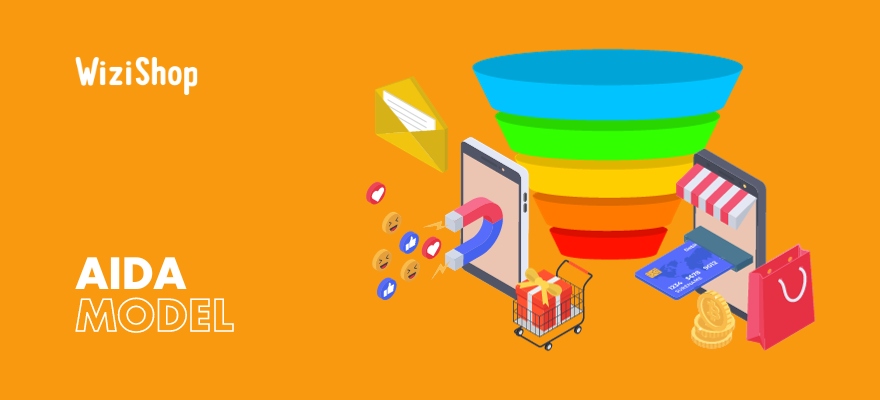Every entrepreneur dreams of making their brand memorable. But with so much competition, especially on the web, it's hard to make a lasting name for yourself in your industry.
It's one thing to start a business, but it's quite another to keep going and attract more and more customers.
To achieve this, marketers have developed successful strategies over the years to enable companies to grow their offerings with the help of marketing.
The AIDA model is one of the most successful of these strategies, available and accessible to all business owners.
Find out what this acronym stands for in this article, and start putting all the levers you need to develop your business in place today!
AIDA model: The marketing strategy's definition and characteristics
What is the AIDA model and what does the acronym stand for?
The AIDA model is the acronym for several actions that define the buying process in marketing: attention, interest, desire, and action. This concept is considered to have been modeled in the 1800s by Elias ST. Elmo Lewis, a leading American advertising executive.
This framework is still popular with salespeople and has proved its worth over the years, although marketing levers have developed over time.
The method is based on four essential pillars of any sales strategy. Using the AIDA model in marketing means building a powerful, captivating message to turn a simple visit into a potential sale.
The AIDA model can be used to construct any type of message with the aim of selling.
Certain online sales tools are considered to be directly linked to the editorial and presentation techniques of the AIDA model: email marketing, product-page creation, newsletters, traditional and online advertising, as well as thematic landing pages.
The AIDA model focuses not only on high-quality editorial content, but also on visuals that appeal to future buyers to convert into customers.
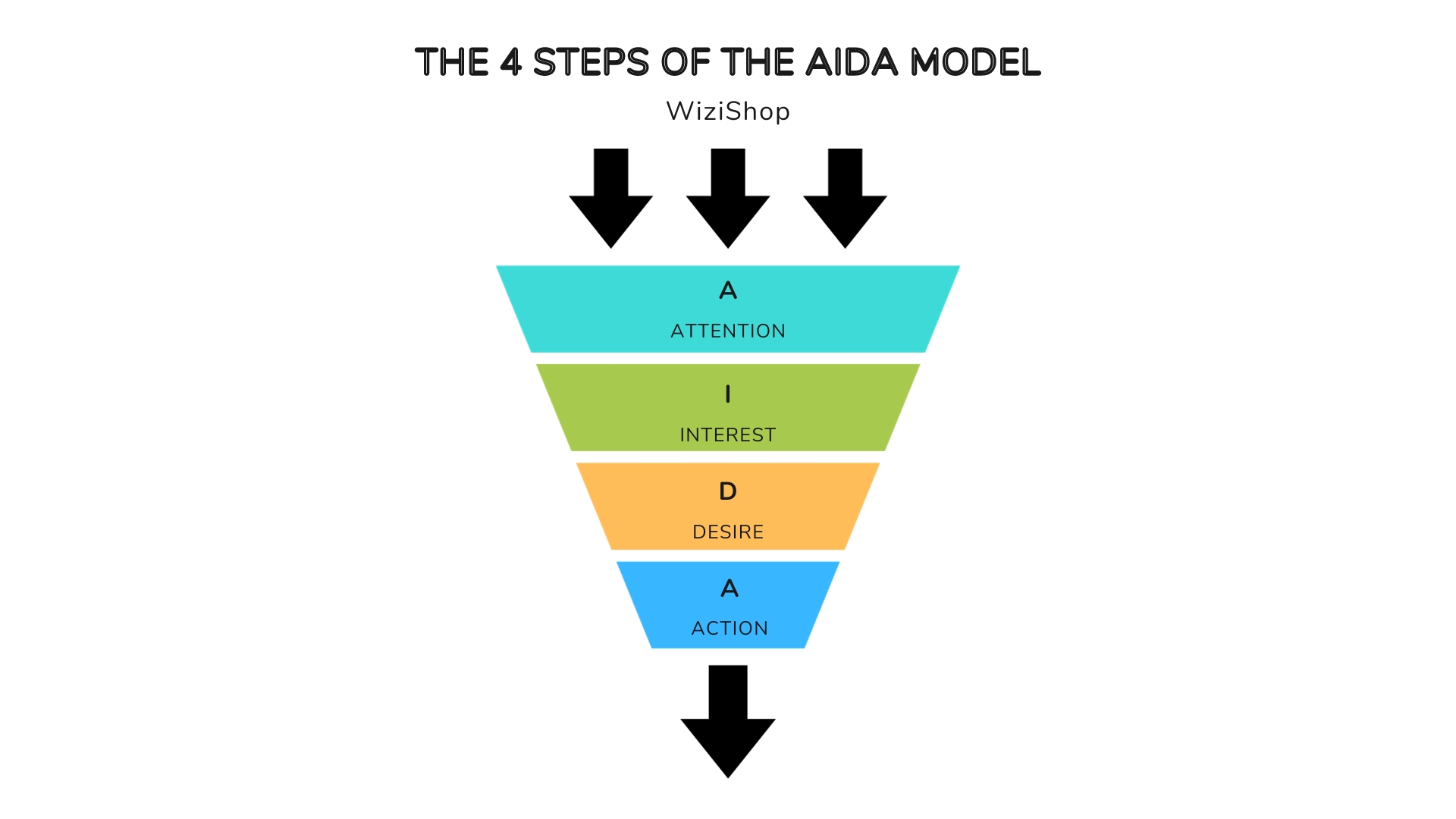
What is the purpose of the AIDA model?
The AIDA model, also known as the AIDA method or framework, enables you to construct precise, effective messages with the aim of optimizing the implementation of a sales funnel.
This method is used in all sales, communication, and marketing activities. We often find this model with regard to communication levers, such as email marketing or online advertising. This acronym helps define the four essential steps or stages that lead to customer conversion: attention, interest, desire, action.
For most messages, these four stages are considered to be the key to achieving the business objective of turning an internet user into a potential customer, for example.
By inciting the prospect's interest and retaining them in the face of an exponential number of commercial offers that surround them, it's then possible to enrich your customer database, increase sales, and build customer loyalty in order to grow your business.
When to use the AIDA model in ecommerce?
In ecommerce, the AIDA model can be used with several types of marketing levers. As we've seen, the method can be deployed on several types of media and content that enable sales messages to become memorable for prospects.
Many marketers develop this strategy on media such as landing pages. This page is relatively static and is used to present a current offer.
Internet users arrive on this page after being invited to click on a link, whether in a commercial email or on social networks. Creating an effective landing page will enable the caller to be taken directly to the page of the offer they're interested in, without having to make unnecessary clicks or go through the trouble of searching for the offer on the ecommerce site.
This type of page, following the AIDA model, is made up of four important elements, linked to the four AIDA stages:
- a highly attractive illustration or visual,
- a prominent page name or offer title,
- all the explanations and reassuring elements that'll give the customer confidence in the proposed offer, and
- a call to action (CTA) redirecting the user to the offer in question.
This type of page contains all the information visitors need to become customers. By piquing interest and being as complete as possible, the entrepreneur can stand out from the competition, while proposing a quality offer to their future customer.
On this type of page, you shouldn't hesitate to add proof of the performance of the product sold, whether in the form of figures and statistics, customer reviews, before-and-after photos, etc.
This type of reassuring proof is a key element in enabling prospects to plan their potential purchase.
What are the 4 phases of the AIDA method?
The AIDA model is not just a fixed marketing method for converting. This technique is based on the different phases a visitor goes through before making a purchase. It's all a question of mindset and putting yourself in the prospect's shoes.
How do you analyze the AIDA model and its four marketing pillars? Here are the explanations, with specific examples.
"A" for capturing Attention with your marketing communication
First of all, attention in marketing is defined as curiosity, the stimulation of novelty, the desire to derive benefit from a situation or problem to be solved.
Capturing attention is therefore the starting point of any sales and marketing approach. The challenge these days is to become memorable in a very short space of time, as consumers are stimulated from all sides, which has drastically limited and diminished their ability to concentrate on the information received.
To attract attention, especially on the internet, to help you get customers in ecommerce, there are several solutions. The key is to be original, without being completely irrelevant: choose a particular color, animate a video that's out of the ordinary, choose your words carefully and construct powerful sentences, formulate a question or promise that'll capture attention, use extreme visuals, either beautiful or shocking, etc.
For example, in this McDonald's UK ad, the consumer is drawn in by recognizing the popular song "Hungry Eyes." The ad's recipient will remain attentive throughout, thanks to the internationally known music.
"I" for inciting Interest (copywriting, concrete examples)
This second pillar of the AIDA model allows you to put the levers in place that'll hold the prospect's attention once you've attracted it.
Here again, there are a number of ways to hold the prospect's attention. This technique generally works by showing the consumer that the entrepreneur is putting themselves in their place, that they understand their problem, with the aim of solving it. The entrepreneur is understanding, they're human, and they've either had a similar experience themselves or they know the problem and becomes legitimate in their value proposition.
This technique points the finger at the target consumer, so that they can relate to the message that follows.
While the first phase of the AIDA method was designed to attract attention, this phase enables us to respond at a glance to a problem, an issue, or simply a need created in the consumer.
This step is not, however, where you'll be able to sell. This stage is still where you lay the foundations for the relationship between the prospect and the company. To do this, the message will appear through a told story, whether through storytelling or copywriting. At this point, the brand can deploy all the elements needed to increase the consumer's desire to convert into a customer.
Another technique is to highlight statistics. In this way, the marketer can rely on precise values and concrete evidence of the problem encountered by the consumer.
In the product page below, we can see that this part of the AIDA model corresponds to the sections containing information on the effectiveness of the serum and its ingredients. With a succession of positive figures, the consumer is more likely to want to give the item a try themselves.
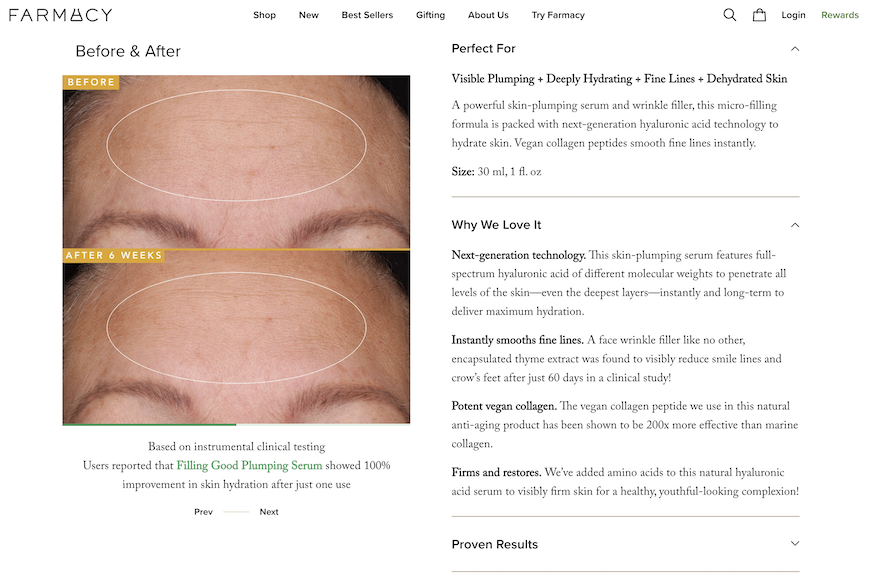
Source: Farmacy Beauty
"D" for amplifying Desire and stimulating the sales decision
At the start of this stage, we can see that the consumer has all the cards in hand to want to be part of the sector presented, without being stimulated to consider buying. The aim now is to go a step further and transform their interest into a genuine desire for your offer.
It's at this point that you should move the strategy towards a more commercial, more direct, and therefore more sales-oriented approach. Here, you can consider presenting your special offer or a benefit that'll leave the consumer no choice but to convert into a customer.
Once you've listed all the elements that make up your prospect's problem, it's time to outline the answers you can provide through your product.
It's here that you can begin to detail all the features present in your product or service, to highlight all the reassuring elements that make up your offer, and to present all the singularities that make you legitimate today to present your offering to consumers. It's at this point that you'll be able to express the uniqueness of your proposition to your target customer.
In addition to explaining the technical features of the item being sold, this is the ideal moment to promote all the benefits and advantages of your offer.
To achieve the goal of this stage of the AIDA method, it's up to you to find the best medium for presenting these key features. Depending on the channel used and your specific target audience, your message may be more relevant in text, video, photo, or other formats.
For example, in the email below, which invites subscribers sign up for the waitlist for Cult Beauty's Advent Calendar, the image featuring all the products included in the calendar as well as the short text all work to create a sense of urgency, encouraging the recipient to activate early access to avoid missing out.
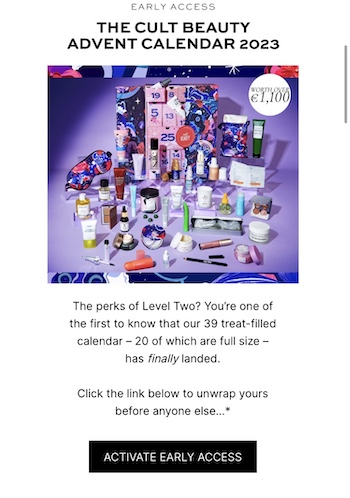
If you want to propose a new offer or simply present one of the facets of your catalog, don't hesitate to surround your "desire" section with customer reviews and user-generated content.
These elements can tip the offer in your favor, especially when you consider that a web surfer will consult 10 different reviews online before buying a product or service.
In short, "D" is the most important step in the sales process:
- It's the time to present the offer and its benefits, the real value proposition (the basic problem and the answer provided by the product or service, the advantages of such a purchase, etc.).
- You'll be able to present the product's precise features and related reassurance elements (customer reviews, demonstration tutorials, direct benefits, guarantees, etc.).
- The prospect will be able to better image how the object of the sale can provide a better future, thanks to the features of your offer.
"A" for Action (add your email, contact details, CTA, etc.)
This is the most direct stage, and should be as simple as possible, so that the prospect can directly find the link to the offer or contact the person who can answer their question.
In the case of a sales email, for example, this is the moment to set up a CTA to encourage the prospect to click on the offer and be redirected to your ecommerce site. In other cases, this may involve setting up a contact form or inviting the web user to call the number indicated there. This stage can also require setting up payment methods so that the prospect can finalize their order.
As you may have guessed, the move to action is the crucial moment when the web surfer becomes a definitive customer, the visitor becomes a newsletter subscriber, or a blog reader becomes a subscriber to the brand's social networking account. On the business side, it's the final invitation that prompts the prospect to take action, and on the prospect's side, it's the step that leads to conversion.
Often, the CTA can be implemented in the form of a popup when arriving on a website. This window will present an offer with a newsletter sign-up form. In a very short space of time, several stages of the AIDA strategy can be implemented in a small, effective insert. Highlighting the form in exchange for a commercial offer is an effective and direct call to action to convert as many visitors as possible into subscribers.
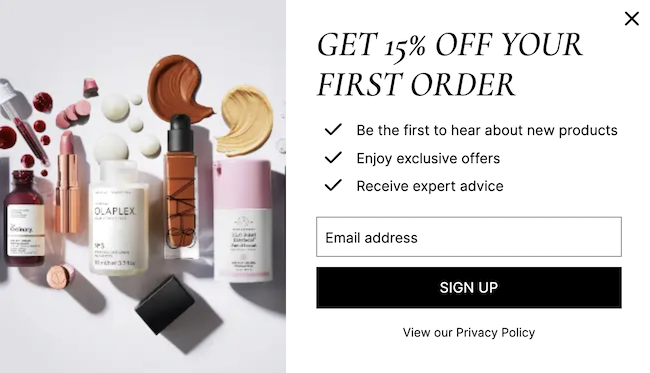
How do you create the desire to buy?
Generating the desire to buy is a process that must follow precise steps in a very specific order. As we've seen, consumers are inundated with information every day. If your message is to have the desired impact with your target audience, your strategy for ecommerce advertising and ecommerce marketing will need to be direct and professional, while paying homage to your brand's DNA.
Even if the aim is to attract the consumer's attention, this doesn't mean transforming your offer into a new image that doesn't suit your product or brand's image.
Generating the desire to buy means not only knowing how to create a need in the internet user, but also knowing how to respond to their problems at the right time and in the right place.
In ecommerce, one of the most important marketing weapons deployed by professionals in the field is search engine optimization (SEO): by appearing in the top results of search engines such as Google, an ecommerce site is going to be able to present its offer to a maximum number of qualified users, web surfers who already want to buy the product in question. In this way, the catalog or product page will start ranking organically for the targeted keywords, and the user can consult the offer naturally in the conversion funnel.
SEO is a marketing lever as effective as it is demanding. With the WiziShop ecommerce solution, your SEO is already optimized for online sales: SEO is an absolute priority for the platform. This means you'll have every chance to attracting as many users interested in your catalog as possible.
Don't wait any longer: test WiziShop with a free 15-day trial and deploy your AIDA strategy through all available marketing levers. Take advantage of free ecommerce training and marketing training modules to take your ecommerce project to the next level!
Try WiziShop free for 7 days
THE EASIEST NO-CODE ECOMMERCE SOLUTION✅ No credit card required
✅ Access to all features
✅ No commitment


